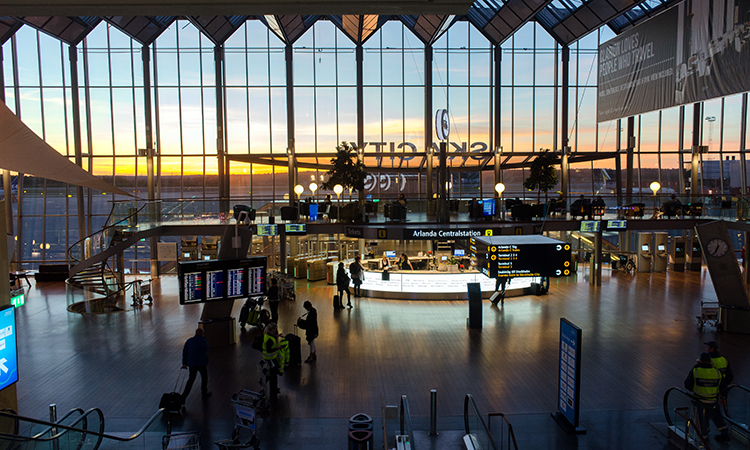Swedavia’s strategy to restore trust and drive sustainable growth in the aviation industry
- Like
- Digg
- Del
- Tumblr
- VKontakte
- Buffer
- Love This
- Odnoklassniki
- Meneame
- Blogger
- Amazon
- Yahoo Mail
- Gmail
- AOL
- Newsvine
- HackerNews
- Evernote
- MySpace
- Mail.ru
- Viadeo
- Line
- Comments
- Yummly
- SMS
- Viber
- Telegram
- Subscribe
- Skype
- Facebook Messenger
- Kakao
- LiveJournal
- Yammer
- Edgar
- Fintel
- Mix
- Instapaper
- Copy Link
Posted: 4 April 2023 | | No comments yet
For Issue 1 2023 of International Airport Review Jonas Abrahamsson, CEO of Swedavia, discussed how the aviation industry can regain the trust of passengers following disruptions last summer, continue driving sustainable transformation, and provide critical connectivity in an increasingly international world.


Sky city at Arlanda Airport.
“As an industry, we need to restore confidence, and we can only do that by working together. Airlines, ground handlers, and airport operators, we are all in it together to deliver a product that lives up to expectations when it comes to punctuality, smooth passenger flow, and a pleasant start to the travel experience”, Jonas Abrahamsson, CEO of Swedavia, said.
It’s hard to find an example of another industry that was hit so hard by the COVID-19 pandemic, and on such a global magnitude as the aviation industry. Last year, however, was dominated by a sharp recovery for the industry and at Swedavia, which welcomed nearly 28 million passengers in 2022 – an increase of more than 130% – compared to 2021. The number of destinations serving Swedavia’s airports also grew sharply through continuous investments by new and existing airline customers reaching more than 300 destinations, and 90% of pre pandemic levels at Stockholm Arlanda Airport.
“We are all now racing to regain not just the critical capabilities we were forced to let go of as a consequence of the health crisis, but the trust of passengers affected by the fallout. At Stockholm Arlanda, we caught up from the second half of the summer thanks to considerable operational efforts and our terrific airport staff. We have since delivered a much better product, also at peak travel periods during this autumn and the past holiday season. Operations have run very smoothly and wating times at the security control for example have been sharply reduced and are back to normal, typically below five to 10 minutes,” Jonas continued.
Investing in tomorrow – improved connectivity and passenger experience
During the pandemic Swedavia decided to press on with some significant investments in modernisation and efficiency projects at Stockholm Arlanda, despite a sharp fall in earnings owing to the effects of the pandemic. Early last summer a key new facility was inaugurated, the airside passage between Terminal 4 and the main Terminal 5 at Stockholm Arlanda. The now interconnected terminal system has since improved operational planning and flexibility for domestic and international connections, majorly increasing Arlanda’s transfer traffic potential.
“We continued with our investment in a new state-of-the-art security control that will streamline passenger screening which will be inaugurated this summer. We will also launch the first phase of the biggest-ever commercial investment at Arlanda – the Marketplace, offering 11,000 square metres of shopping, food and other services. By markedly improving the travel experience at Arlanda, these investments will contribute to our efforts to regain our passengers’ trust and we will continue to evaluate new investment projects pending on the traffic development going forward,” Jonas added .
On the operations front, one big lesson from the restart after the pandemic has been the need to promote the industry and the airport as a great workplace. Stockholm Arlanda, as with many other airports around Europe and in the world, faced considerable challenges in finding staff throughout the ecosystem of the airport and particularly Swedavia’s security services partner. “Thousands” of new employees are now needed at Arlanda to meet the expected growth and future investments at the airport.
“It’s clear that we are competing with the entire tourism industry – restaurants, hotels, and other hospitality venues – and we must ensure that we are attractive as an employer. The industry should appeal to the best people,” said the CEO.
Ahead of the expected busy summer travel season and the new commercial and operational launches at Stockholm Arlanda, the first major job fair in several years was held in late January at the airport in collaboration with more than thirty airport partners – a job fair that attracted some thousand visitors.
Jonas went on to say: “One key area in regaining trust in the short and long-term is by taking climate issues seriously and continuing to drive the transformation to a sustainable future transportation mode. Only then will we be truly attractive to the younger generation from whom we need to recruit,”
Piloting sustainable solutions – world leadership in fossil-free airport operations
During late 2020, Swedavia became the first airport group in the world to reach the goal of being fossil-free in our own operations at all ten of our airports. This achievement was the result of more than a decade of relentless work and continuous striving with partners to develop new products, services and ways of working.
“When the pandemic broke out, we streamlined our operations to the most critical. This was painful but essential, and despite the unprecedented challenges we emerged stronger. It means we can support airlines in developing fossil-free solutions and allows us to confidently engage with broader industry challenges,” said Jonas Abrahamsson.
Going forward, one of Swedavia’s major sustainability goals is that 5% of all fuel refuelled at Swedish airports should be fossil-free by 2025. To support this aim, every year since 2016, Swedavia has purchased biofuel equivalent to the amount of jet fuel used for its own business travel. Swedavia has now opened up the procurement scheme to other parties in order to promote sustainable corporate travel and to create a demand in order to get the necessary investments for the large-scale production of Sustainable Aviation Fuel (SAF).
A few years back, Swedavia also introduced a successful and innovative SAF incentive programme offering airline customers a 50% funding of the premium cost for the usage and refuelling of SAF. This year, Swedavia plans to double the financing of the programme.
“Going forward, we must focus on initiatives that drive the development of fossil-free aviation in line with the industry’s roadmap. We’re intensifying work to help other companies and organisations operating at our airports to adapt to more sustainable operations. Many airlines – such as SAS and one of our key domestic partners, BRA, which in partnership with Volvo recently launched its first 50% SAF-equivalent operated commercial route – are taking huge steps in the right direction, demonstrating that we’re not just talking but making serious progress.
We’re also a very proud partner on the advisory board of Heart Aerospace, a world-leading developer of electric aircraft based in Gothenburg, and are preparing our airports for electric aviation. Additionally, we’re exploring opportunities for hydrogen-powered flights,” continued Jonas.
Increasing Swedish connectivity – aviation is key
Sweden spans 1,600km from South to North and aviation is necessary to keep the country running. Swedes are frequent travellers, and a third of the population has a foreign background, more than any other Nordic country. There is also a growing industry, most notably the new climate tech industry in the North of Sweden, which will require more human resources boosting the demand for travel and connectivity.
“The world is ever more international, and aviation has a huge role to play in the future. We are continuously striving to increasing capacity and connectivity at our airports to accommodate this growth. It’s gratifying to see that, as the biggest market in the Nordics, there is great interest from airlines. Swedavia’s airports served more than 300 destinations in 2022, meaning that a large share of the loss of destinations due to the pandemic has been recovered.
“We are evidently very happy to see that demand so far has remained robust and resilient despite many uncertainties and challenges around the world. Travel has clearly been a priority to many following the ending of travel restrictions. As we all know, flying remains in many cases the unrivalled mode of transport when it comes to real life meetings, be it to meet friends and family or professionally.”
A number of Swedavia’s airports improved connectivity throughout the year, and notably key regional airports such as Luleå Airport, up far in the north of the country, where three new direct international routes – including London and Paris – were launched in December. Recently a major new direct route by SAS from Gothenburg to New York was announced for this spring.
“And we’re seeing great investments and a keen interest in Arlanda, with existing and new customers such as Ryanair and Eurowings significantly increasing their presence and the destination offering to the benefit of travellers from Sweden. But also to Sweden, which is a travel and holiday destination as such.”, said Jonas.
Despite the uncertainties in the global economy, Swedavia expects a strong travel summer and we are now rigorously preparing for it. At Stockholm Arlanda, new operational measures are planned for and being implemented continuously, such as new check-in facilities as well as non-Schengen traffic resuming at Terminal 2, for the first time since the start of the pandemic.
Operational preparations aside, Jonas also stresses the need to address the potential challenges posed by the implementation of EU’s new border control system – Entry/Exit System, EES.
“The goal of strengthening the Schengen area is evidently not up for debate, but it’s crucial to implement the system with minimal disruption. Dialogue and cooperation are of the utmost importance – not only across the industry but also with politicians and the Commission in Brussels.
“All players however in the ecosystem must be prepared, and I hope that airlines and ground handlers will be able to deliver on the high demand this summer. At Swedavia we will do our utmost to be ready. I am confident that together we will be able to recover our passengers’ trust and give them the travel experience they expect – and perhaps a little more.”


Jonas Abrahamsson is a senior Swedish business leader and CEO of Swedavia since 2017, with an extensive background in managing large infrastructure investments in Swedish and internationally, with climate change transition at the core. Before joining Swedavia he held a number of senior management positions at E.ON Group, notably as CEO for the Nordics. Jonas Abrahamsson is a Board of Director at ACI Europe, the Confederation of Swedish Enterprises and chairman at Stockholm Exergi. He holds a Bachelor in Business Adminstration from Lund University.
Issue
Related topics
Passenger experience and seamless travel, Passenger volumes, Security, Social responsibility, Sustainability, Sustainable Aviation Fuel (SAF), Sustainable development


















